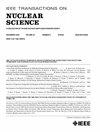A Dynamically Reconfigurable Readout Scheme of a Pixel Readout ASIC for Space X-Ray Imaging
IF 1.9
3区 工程技术
Q3 ENGINEERING, ELECTRICAL & ELECTRONIC
引用次数: 0
Abstract
A grazing-incidence X-ray telescope is an instrument to observe X-rays emitted by solar activities such as solar flares and coronal mass ejections. A hybrid X-ray imaging detector consisting of a radiation sensor and a readout integrated circuit (ROIC) is required to measure both the energy and counting rate of incident X-ray photons. In this application, the data of interest in the images are concentrated in the region where solar activities occur, and most of the data are irrelevant. Thus, a reconfigurable readout scheme is necessary to obtain a shorter readout time and provide more accurate observational data. In this article, we propose a novel two-step dynamically reconfigurable readout scheme. First, a frame of trigger flag information is read out, and the addresses of the triggered pixels are generated through mode arbitration. Then, the data of interest are read out according to the pixel addresses. The advantage of such a scheme lies in that it can support not only region-of-interest (ROI) readout but also autonomously transitions between full-frame readout and zero-suppression readout modes based on the number of active pixels. To verify this readout method, a用于空间 X 射线成像的像素读出专用集成电路的动态可重构读出方案
掠射x射线望远镜是一种观测太阳活动(如太阳耀斑和日冕物质抛射)发出的x射线的仪器。为了测量入射x射线光子的能量和计数率,需要一种由辐射传感器和读出集成电路(ROIC)组成的混合x射线成像探测器。在这个应用中,图像中感兴趣的数据集中在太阳活动发生的区域,大多数数据是不相关的。因此,为了获得更短的读出时间和提供更准确的观测数据,需要一种可重构读出方案。在本文中,我们提出了一种新的两步动态可重构读出方案。首先,读出一帧触发标志信息,并通过模式仲裁生成触发像素的地址。然后,根据像素地址读出感兴趣的数据。该方案的优点在于不仅支持感兴趣区域(ROI)读出,而且可以根据活动像素的数量在全帧读出和零抑制读出模式之间自主转换。为了验证这种读出方法,在180纳米CMOS工艺中设计了一个$32\ × 32$像素读出ASIC原型。数据读出方案由片上数字控制器和现场可编程门阵列(FPGA)板上的外部逻辑电路实现。ASIC已经过测试。在10%的活动像素率下,与全帧读出模式相比,读出时间减少了77.5%。实测数据表明,在测试时钟频率为3.125 MHz的情况下,ASIC实现了动态实时数据读出,帧率超过190帧/秒。
本文章由计算机程序翻译,如有差异,请以英文原文为准。
求助全文
约1分钟内获得全文
求助全文
来源期刊

IEEE Transactions on Nuclear Science
工程技术-工程:电子与电气
CiteScore
3.70
自引率
27.80%
发文量
314
审稿时长
6.2 months
期刊介绍:
The IEEE Transactions on Nuclear Science is a publication of the IEEE Nuclear and Plasma Sciences Society. It is viewed as the primary source of technical information in many of the areas it covers. As judged by JCR impact factor, TNS consistently ranks in the top five journals in the category of Nuclear Science & Technology. It has one of the higher immediacy indices, indicating that the information it publishes is viewed as timely, and has a relatively long citation half-life, indicating that the published information also is viewed as valuable for a number of years.
The IEEE Transactions on Nuclear Science is published bimonthly. Its scope includes all aspects of the theory and application of nuclear science and engineering. It focuses on instrumentation for the detection and measurement of ionizing radiation; particle accelerators and their controls; nuclear medicine and its application; effects of radiation on materials, components, and systems; reactor instrumentation and controls; and measurement of radiation in space.
 求助内容:
求助内容: 应助结果提醒方式:
应助结果提醒方式:


